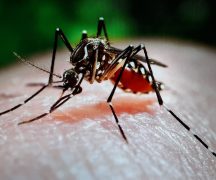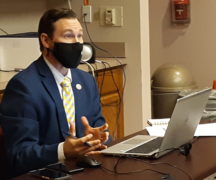By JAN LARSON McLAUGHLIN
BG Independent News
For smokers looking to snuff out their tobacco habits in the new year, the Wood County Health Department stands ready to help.
According to the 2021 Community Health Assessment, 10% of Wood County adults smoke. Of those, 58% tried to stop smoking in the previous year. But fewer than 10% were able to quit without help of coaching or medications to kick nicotine.
“Most people who smoke want to quit. But people need help to quit,” said Beth Peery, public health information and education manager at the Wood County Health Department.
The rate of smokers in Wood County is less than half of the 21% rate for all of Ohio. But because tobacco causes so many serious health issues, the Wood County Health Department was awarded a tobacco cessation grant from the state.
“We’re better off than the state of Ohio,” Peery said. “Because smoking is just so harmful, and it’s preventable, it’s worth it even if our rates aren’t terrible.”
A goal of getting the national rate of smoking down to 5% of the population has been set in the national Healthy People 2030 plan.
Ohio has a long way to go to meet that goal, with it currently ranking fourth in the nation for the highest percentage of smokers, behind West Virginia, Kentucky and Louisiana.
Cigarette smoking harms nearly every organ of the body and causes many illnesses, including cardiovascular disease; heart attack; stroke; heart disease; several types of cancer including cancer of the lung, throat, mouth, esophagus, pancreas, bladder, cervix, and leukemia; respiratory diseases; chronic obstructive pulmonary disease (COPD); emphysema; and chronic bronchitis.
Tobacco smoke also affects and worsens many other diseases such as diabetes, vascular disease, and osteoporosis. It can contribute to other problems such as gum and tooth disease.
“It’s associated with so much chronic illness,” Peery said. “Quitting is something people can do to improve their health. As people start to look toward the new year and create New Year’s resolutions, we think this is a good time to start this conversation.”
Resources are available to help people who smoke, vape or use other tobacco products to kick their habits:
- Ohio Quitline: The Ohio Quitline is a free tobacco cessation program for Ohio residents, based on proven strategies that have helped more than 1.5 million people quit tobacco. Through the Quitline, professional quit coaches and an online community provide support, as well as free access to nicotine quit medications. Whether you’re ready to quit now, are curious about quitting or you’re supporting a loved one who uses tobacco, the Quitline can help. Call 1-800-QUIT-NOW to get started or go to https://ohio.quitlogix.org/en-US/About-The-Program/Quitline-Programs to get more information, chat with a coach or sign up online. When you call or go online to contact the Quitline via live chat, you’re immediately connected to a qualified quit coach who will work with you to understand your situation, prescribe nicotine replacement therapy and provide other strategies to help you stop using products with nicotine.
- Wood County Community Health Center Wellness Resources: Wood County Community Health Center also provides counseling, including support to help you quit smoking. Call 419-354-9049 to make an appointment.
“Our multi-disciplinary team works alongside you to help develop a plan to quit smoking,” said Fran Leass, behavioral health specialist at Wood County Health Department. “We can work in tandem with the support you get through the Quitline or provide help with other issues you may be facing such as anxiety or depression.”
“It’s a phone call away, or you can go online and sign up,” Peery said.
Cigarette smoking is the leading cause of preventable death in the U.S. According to the Centers for Disease Control:
- Cigarette smoking causes more than 480,000 deaths each year in the U.S. This is nearly one in five deaths.
- More than 10 times as many U.S. citizens have died prematurely from cigarette smoking than have died in all the wars fought by the U.S.
- Smoking causes about 90% of all lung cancer deaths.
- Smoking causes about 80% of all deaths from chronic obstructive pulmonary disease (COPD).
- The risk of dying from cigarette smoking has increased over the last 50 years in the U.S.
- Smoking causes diminished overall health, increased absenteeism from work, and increased health care utilization and cost.
Quitting smoking lowers the risk for smoking-related diseases and can add years to a person’s life.
“You can really undo the damages by quitting,” Peery said.
While quitting earlier in life yields greater health benefits, quitting smoking is beneficial to health at any age, according to the CDC. Even people who have smoked for many years or have smoked heavily will benefit from quitting. Quitting smoking is also the single best way to protect family members, coworkers, friends, and others from the health risks associated with breathing secondhand smoke.
According to the Ohio Department of Health, bodies start repairing as soon as smoking stops. For example, within:
- 20 minutes: Blood pressure decreases, pulse rate drops, body temperature of hands and feet increases.
- 8 hours: Carbon monoxide level in blood drops to normal, oxygen level in blood increases to normal.
- 24 hours: Chance of a heart attack decreases.
- 48 hours: Nerve endings start regrowing, sense of smell and sense of taste improve.
- 2 to 12 weeks: Circulation improves, walking becomes easier, lung function improves.
- 4 to 36 weeks: Coughing, sinus congestion, tiredness and shortness of breath decrease.
- 1 year: Risk of coronary heart disease decreases to half that of smokers.
- 5 years: From 5 to 15 years after quitting, stroke risk is the same as people who never smoked.
- 10 years: Risk of cancer drops to half that of smokers, risk of ulcers decreases.
- 15 years: Risk of coronary heart disease is the same as people who have never smoked, risk of death is the same as people who have never smoked.
The tobacco cessation efforts will also address vaping and chewing tobacco. E-cigarettes are considered tobacco products because most of them contain nicotine, which comes from tobacco. Besides nicotine, e-cigarettes can contain harmful and potentially harmful ingredients, including: ultrafine particles that can be inhaled deep into the lungs.
“Our focus is all use of tobacco and nicotine,” Peery said.





